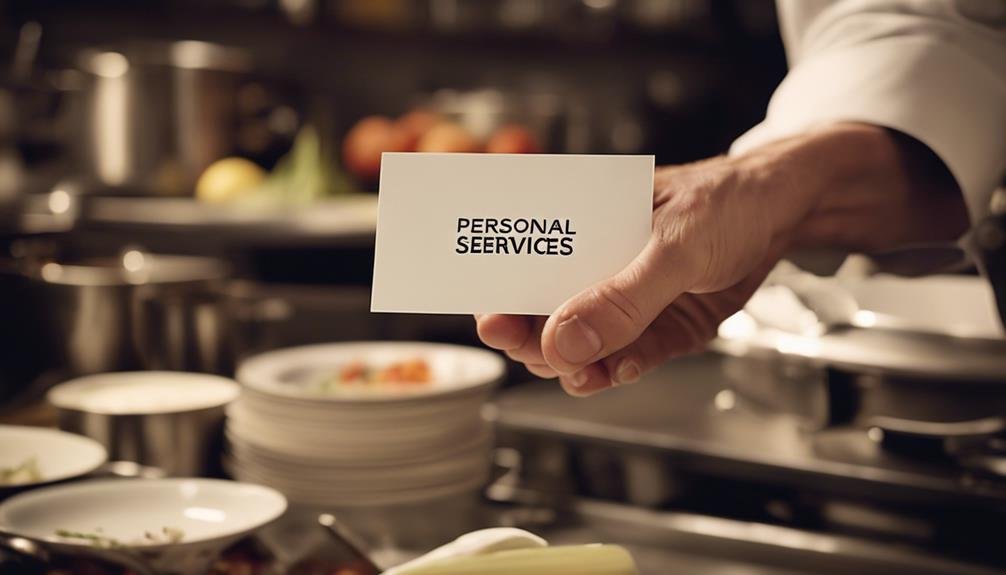How to Start a Personal Chef Business
Embarking on the journey of starting a personal chef business is like preparing a feast where every ingredient must be carefully selected and skillfully combined to create a harmonious symphony of flavors. As you take the first steps into this culinary adventure, envision the satisfaction of turning your passion for food into a successful enterprise.
With a strategic roadmap in hand, you'll navigate through the complexities of establishing your brand, pricing your services, and attracting a loyal clientele. But remember, the true recipe for success lies in your ability to adapt, innovate, and rise above the competition.
Key Takeaways
- Develop a detailed business plan outlining goals and financial projections.
- Conduct a thorough cost analysis and research competitors' pricing strategies.
- Focus on legal compliance, brand building, and unique value proposition.
- Showcase culinary skills with diverse, personalized menu options to engage clients.
Crafting Your Business Plan
Crafting your business plan sets the foundation for the success of your personal chef business, outlining your goals, strategies, and financial projections. When creating financial projections, consider factors like initial investment, operating expenses, and potential revenue streams. This will help you understand the financial viability of your business and set realistic goals for growth.
Additionally, your marketing strategy is crucial to reaching your target market effectively. Conducting a competitive analysis allows you to identify your competitors' strengths and weaknesses, giving you valuable insights to differentiate your services and stand out in the market.
Your business plan should reflect a deep understanding of your target market's needs and preferences. Tailor your marketing strategy to appeal to this specific audience, highlighting what sets you apart from competitors. By incorporating detailed financial projections and a comprehensive marketing strategy into your business plan, you lay a solid groundwork for the future success of your personal chef business.
Setting Your Pricing Structure
Wondering how to strategically set your pricing structure to maximize profitability and attract clients to your personal chef business? To ensure your pricing is competitive and sustainable, you must conduct thorough cost analysis and market research. Here's how you can go about it:
- Cost Analysis: Calculate all your expenses, including ingredients, equipment, transportation, insurance, and overhead costs. This will help you determine your base cost for each service you offer.
- Market Research: Investigate your competitors' pricing strategies and the average rates in your area. Understanding what clients are willing to pay for personal chef services will guide you in setting your prices effectively.
- Value Proposition: Highlight the unique value you bring to your clients, whether it's customized menus, dietary expertise, or exceptional service. Communicating this value will justify your pricing to potential clients and set you apart in the market.
Obtaining Necessary Permits and Licenses
To operate your personal chef business legally and professionally, securing the necessary permits and licenses is crucial. Applying for permits and licenses demonstrates your commitment to compliance with regulations and requirements, setting the foundation for a successful venture. The specific permits and licenses needed can vary depending on your location, so it's essential to research the local laws thoroughly.
Common permits for personal chef businesses may include health department permits, business operation licenses, and food handling certifications. Ensuring that you're in compliance with all necessary regulations won't only protect your business from potential fines or closures but also build trust with your clients.
Before diving into the culinary world, take the time to understand the legalities involved in operating a personal chef business. By obtaining the required permits and licenses, you're not only fulfilling legal obligations but also showing your dedication to professionalism and excellence in your craft. Stay informed, stay compliant, and set the stage for a thriving personal chef business.
Building Your Culinary Brand
Securing the necessary permits and licenses sets the legal foundation for your personal chef business, now let's explore how to effectively build your culinary brand. To establish a strong presence in the market, it's crucial to focus on branding strategies and target market identification.
- Branding Strategies
- Develop a unique selling proposition that sets you apart from competitors.
- Create a memorable logo and consistent visual identity for your business.
- Utilize social media platforms to engage with potential clients and showcase your expertise.
Identifying your target market is essential for tailoring your brand message and services to attract the right customers. Conduct market research to understand the demographics, preferences, and needs of your target audience. By aligning your branding strategies with the interests and values of your target market, you can effectively communicate the value of your personal chef services and build a loyal customer base. Remember, a strong culinary brand not only attracts clients but also fosters trust and credibility in your business.
Creating a Professional Menu
Crafting a professional menu for your personal chef business is crucial to showcasing your culinary skills and enticing potential clients.
Menu planning tips will help you curate a diverse and appealing selection of dishes that cater to different tastes and dietary preferences.
Consider a pricing strategy that reflects the quality of your ingredients, the complexity of your recipes, and the value you bring to your clients' dining experience.
Menu Planning Tips
When designing a professional menu for your personal chef business, consider incorporating a diverse range of flavors and textures to tantalize your clients' taste buds. Start by utilizing seasonal ingredients to ensure freshness and quality in your dishes.
Get creative with your menu offerings, experimenting with unique flavor combinations and innovative cooking techniques to set yourself apart. Remember to take into account client dietary restrictions when planning your menu, offering customized options that cater to specific needs and preferences.
By crafting a menu that showcases seasonal ingredients, creative dishes, and personalized choices, you can create a memorable dining experience that keeps your clients coming back for more.
- Utilize seasonal ingredients
- Get creative with dishes
- Cater to client dietary restrictions
Pricing Strategy Considerations
Considering the meticulous balance between cost-effectiveness and value for your clients, pricing your professional menu demands strategic forethought and precision. Conduct a competitive analysis to understand pricing trends in the personal chef industry, tailored to your specific target market. Your value proposition should be clear in your pricing strategy, reflecting the quality of your ingredients, culinary expertise, and exceptional service. When creating your menu, think about different revenue streams such as offering packages for special occasions or themed cooking classes. By aligning your prices with the perceived value of your services and understanding the needs of your target market, you can set competitive prices that attract clients while ensuring profitability.
| Pricing Strategy | Description | Example Pricing |
|---|---|---|
| Competitive Analysis | Evaluate competitor pricing to set competitive rates | $50 per person |
| Target Market | Tailor prices to meet the needs of your specific audience | $300 for a 3-course meal |
| Revenue Streams | Explore various options to maximize income potential | $150 for cooking class |
Marketing Your Services Effectively
To effectively market your personal chef services, pinpointing your target audience and tailoring your approach to their specific needs and preferences is crucial. Understanding the power of social media and implementing effective marketing strategies can significantly boost your business. Here are some key points to consider:
- Utilize Social Media Platforms: Engage with potential clients on platforms like Instagram, Facebook, and Twitter. Share visually appealing photos of your dishes, post cooking tips, and interact with followers to build a strong online presence.
- Offer Promotions and Discounts: Entice new clients by offering special promotions or discounts for their first booking. This can help attract customers who are looking for a cost-effective way to experience your services.
- Collect and Showcase Testimonials: Encourage satisfied clients to leave reviews and testimonials on your website or social media pages. Positive feedback can build trust with potential clients and showcase the quality of your services.
Networking With Potential Clients
When starting your personal chef business, nurturing client relationships is key to success. Engage with potential clients on social media platforms to showcase your skills and services.
Additionally, attending food events allows you to network and interact with individuals who may be interested in hiring a personal chef.
Build Client Relationships
Establishing strong connections with potential clients through effective networking is key to the success of your personal chef business. Engage in local events, food festivals, and cooking demonstrations to showcase your skills and attract new clients.
Remember, the goal isn't just to gain clients but to build long-lasting relationships that foster client retention and customer loyalty. Here are some essential tips to help you network effectively:
- Personalized Interactions: Take the time to get to know your clients on a personal level to understand their preferences and dietary needs.
- Consistent Communication: Stay in touch with your clients regularly to show them that you value their business.
- Exceptional Service: Go above and beyond to exceed your clients' expectations and leave a lasting impression.
Utilize Social Media
Engaging with potential clients through social media platforms is a powerful way to expand your personal chef business and establish meaningful connections in the digital age.
To effectively reach your audience, develop social media strategies that showcase your culinary expertise and unique offerings. Maintain an active online presence by regularly posting engaging content, such as cooking tips, behind-the-scenes glimpses, and client testimonials.
Interact with followers by responding to comments and messages promptly, demonstrating your dedication to customer service. Utilize platforms like Instagram, Facebook, and Twitter to share mouth-watering photos of your dishes and promote special services or discounts.
Attend Food Events
To effectively network with potential clients and expand your personal chef business, attending food events is a strategic way to showcase your culinary skills and connect with individuals who appreciate fine dining experiences.
- Food Festivals: Participating in food festivals allows you to introduce your unique dishes to a diverse audience and create lasting impressions.
- Networking: Engaging with other professionals in the industry at culinary workshops can lead to valuable connections and collaborations for your business growth.
- Promotions: Offering special promotions or discounts at these events can attract new clients and generate buzz around your personal chef services.
Managing Your Finances and Operations
Mastering the financial management and operational strategies of your personal chef business is key to its success and longevity. To ensure your venture thrives, start by understanding budgeting basics. Create a detailed budget that covers all expenses, from ingredients to equipment maintenance, and allocate funds wisely to maximize profitability. Tracking your income and expenses diligently will provide valuable insights into your business's financial health and help you make informed decisions.
Operational efficiency is another crucial aspect to focus on. Streamline your processes to save time and resources while maintaining high-quality service. Develop standardized recipes, optimize your kitchen layout, and establish efficient scheduling practices to enhance productivity. By maximizing operational efficiency, you can increase output without compromising on the quality of your dishes.
Conclusion
Now that you have the tools and knowledge to start your personal chef business, the world is your oyster!
With a dash of creativity and a sprinkle of determination, you can turn your culinary dreams into a sizzling reality.
So don't just dip your toes in the water, dive in headfirst and let your flavors shine like a beacon in the night sky.
The kitchen is your canvas, so go forth and create a masterpiece!







